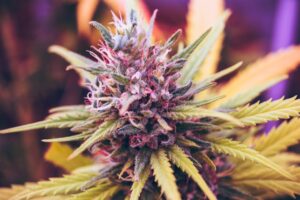Your cannabis plants’ vegetative phase is crucial because this lays the groundwork for the flowering phase. Knowing how to optimize the vegetative growth stage can help you provide your cannabis plants with the right care and growing conditions for a strong flowering stage.
This 3 to 16-week phase requires lots of light, water, and nutrients to keep the plant growing. Ensure they have enough energy to grow by keeping the light cycle about 18/6 – 18 hours of light and 6 hours of darkness. By mastering this stage, you pave the way for larger yields and healthier plants when it’s time to flower.
As you learn more about this important phase, you will pick up valuable techniques to enhance your cannabis cultivation experience. From identifying plant health to caring for your young plants, each aspect will contribute to a successful harvest.
Key Takeaways
- Growing strong cannabis plants requires a healthy vegetative phase.
- A healthy grow medium requires proper light, moisture, and nutrient management.
- Understanding the cannabis vegetative stage prepares you for the flowering phase.
Understanding Cannabis’ Vegetative Phase
Cannabis plants need a good veg stage to grow strong. This stage of cannabis growth prepares plants for flowering by strengthening the roots and leaves.
Definition and Importance
During the vegetative growth, cannabis plants grow leaves, branches, and roots. This stage generally follows the seedling phase and lasts several weeks. During this time, the plants grow taller and bushier, establishing a robust structure.
This stage improves later harvests and is vital to overall plant health. Strong foliage can support large buds during blooming. This stage requires water, nutrients, and light. Nitrogen is especially essential for leaf growth and growth.
Transition from the Seedling Stage
Cannabis plants shift from the seedling to the vegetative phase when they reach a certain height and start producing leaves.
This transition occurs more easily if the plants are given 18 hours of light and 6 hours of darkness daily. True leaves, which are larger and more developed than seed leaves, will appear. This transition is critical, as it sets up the plant for a successful growth cycle.
Provide the correct care throughout this period and your plants will thrive. To ensure appropriate development, monitor light, water pH, and nutrients closely.
Optimal Conditions for Vegetative Growth
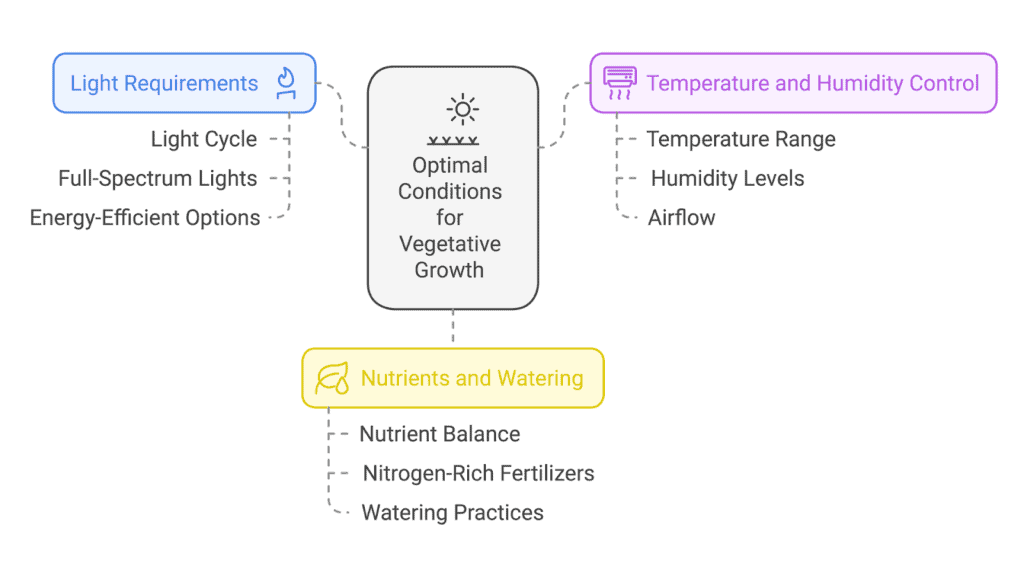
Cannabis needs the right atmosphere during vegetative growth. You must efficiently control light, temperature, humidity, fertilizers, and water to ensure healthy growth.
Light Requirements
Cannabis plants need lots of light during vegetative growth. A typical light cycle is 18 hours of light and 6 hours of darkness. This prevents early flowering and boosts growth.
Full-spectrum grow lights power photosynthesis by mimicking natural sunshine. Avoid scorching your plants by placing the light 12–24 inches above the plants. Change the height as plants grow.
Energy-efficient lighting options include fluorescent and LED. Always monitor plant light because too little might stunt plant growth and too much can stress them.
Temperature and Humidity Control
Cannabis plants need the proper temperature to promote growth. The ideal temperature is 20–30°C (68–86°F). Nighttime temperatures should be about 2°C lower.
Try to keep humidity between 40 and 70%. Start high during early vegetative growth and gradually reduce it as the plants grow. This keeps mold away and controls humidity.
Airflow can be increased by fans or ventilation systems. Additionally, a hygrometer can accurately measure humidity. Stable conditions promote root and foliage growth.
Nutrients and Watering
Plants need balanced nutrition during vegetative growth. Consider liquid or organic fertilizers for easier absorption. Follow manufacturer instructions to avoid overfertilization. The right nutrients are needed for optimal growth.
Focus on nitrogen-rich fertilizers to boost leaf and stem growth. Add potassium and phosphorus for overall plant health.
Adequate watering is essential. Cannabis prefers drier soil to avoid root rot, so check soil moisture before watering. Water thoroughly and let excess run off.
Cannabis Vegetation Techniques
Cannabis plant growth during vegetative growth can be considerably increased using the right approaches. Plant training and care can help your indoor grow room produce healthier, more productive plants.
Training Techniques
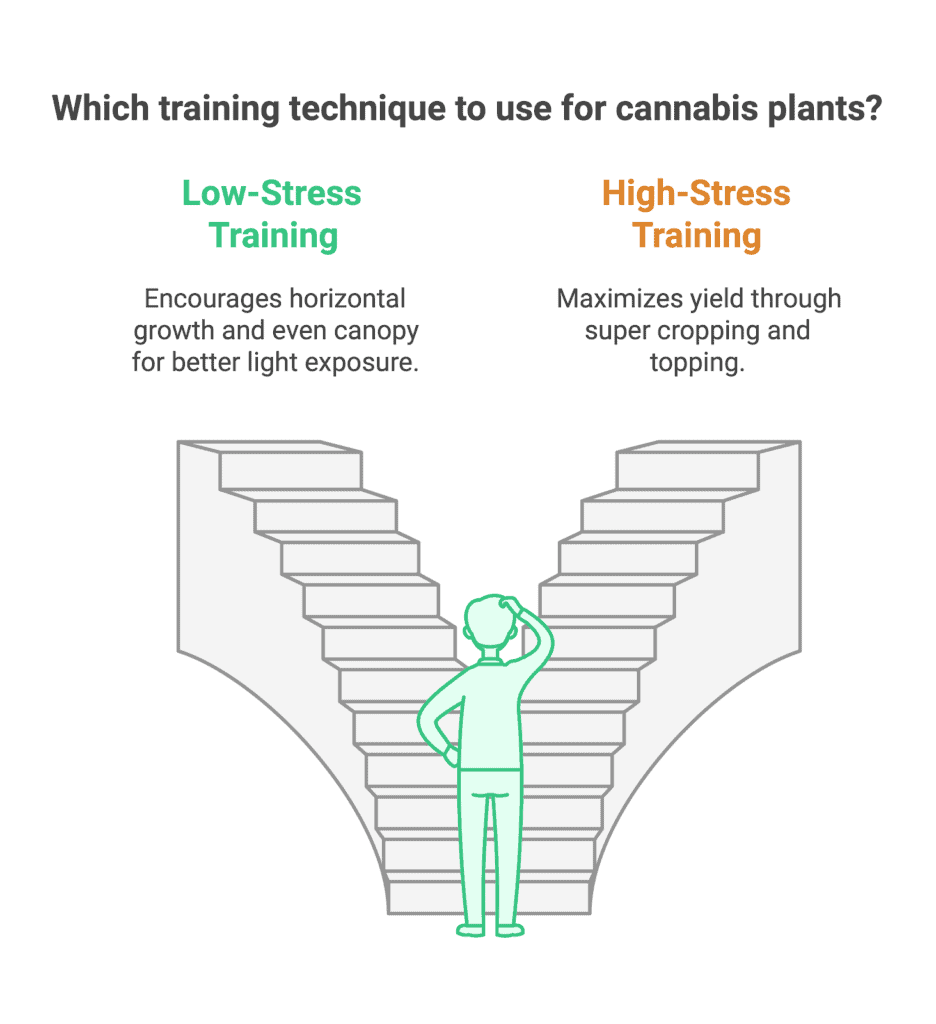
Cannabis growers use training to control plant growth. Techniques like Low-Stress Training (LST) and High-Stress Training (HST) manipulate your plants without causing harmful damage.
- Low-Stress Training (LST): Bend and knot branches gently for horizontal growth. It creates an even canopy and increases light exposure.
- High-Stress Training (HST): Involves super cropping and topping. Topping removes the main stem to promote lateral branch growth, while super cropping creates bends branches to maximize yield.
Pruning and Maintenance
Routine pruning and care are essential throughout the vegetative phase. This will help your cannabis grow robust branches during this stage of growth.
This helps reduce unwanted growth by cutting off lower branches and leaves that receive less light. This lets your plant focus on healthy growth.
Monitor your growth medium’s nutrient levels, water, pH, and light schedules. Change these as needed to protect your plants.
Identifying and Understanding Cannabis Sex
Sex identification is crucial for cannabis plant growth. Knowing whether your plants are male or female affects your growing method and yield quality. This section discusses female cannabis plants’ role in the life cycle.
Significance of Female Plants
Female cannabis plants are essential for producing the buds you want to harvest. They develop flowers that are rich in cannabinoids, particularly THC and CBD. This is what most growers seek.
Cultivating with conventional cannabis seeds requires early female plant identification. Male marijuana plants pollinate females to generate seeds, not buds. Separate them for maximum yield.
Look for pre-flowers forming about 5 to 6 weeks into the vegetative stage. Female pre-flowers have small, wispy structures, whereas males have spherical sacs. Catching them at the right time will maximize growth and prevent unintentional pollination.
Preparing for the Flowering Stage
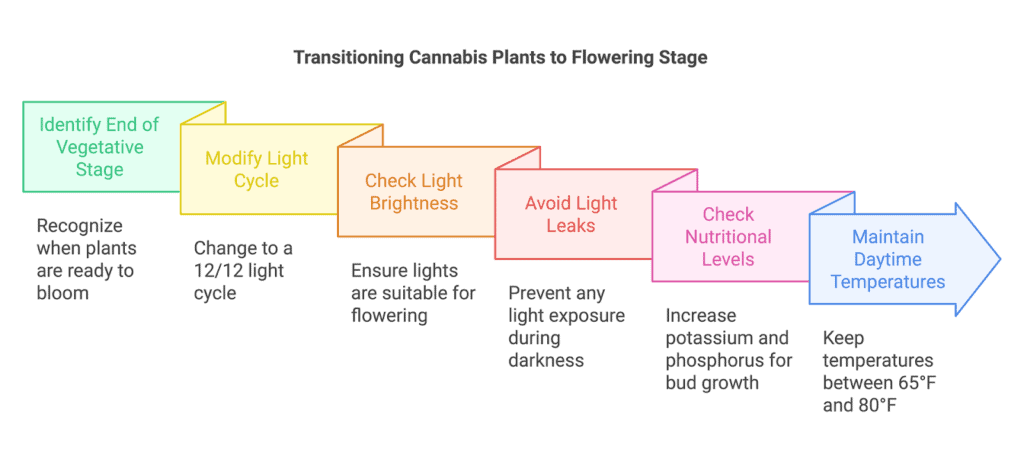
As they finish vegetating, cannabis plants must be prepared for blooming. Knowing how to transition plants successfully will yield the finest results.
Transitioning Techniques
Flowering requires light cycle modification. Cannabis plants need 18 hours of light and 6 hours of darkness during vegetative growth. When flowering begins, switch to a 12/12 light cycle. This requires 12 hours of constant light and 12 hours of darkness.
Tips for Transitioning:
- Check the light brightness: Ensure your lights are suitable for flowering.
- Avoid light leaks: Flowering requires complete darkness to promote bud growth.
- Check nutritional levels: Increase potassium and phosphorus for bud growth and alter nutrients for flowering.
Flowering Triggers
Light influences flowering. When the light cycle is changed to 12/12, plants usually start flowering.
These other aspects may aid this transition:
- Maintain daytime temperatures between 65°F and 80°F and nighttime temps slightly lower.
- Maintaining humidity between 40 and 50% which prevents mold on emerging buds.
- Some producers use minor defoliation to stimulate flowering but be careful.
Manage these conditions to grow healthier plants and better buds.
Caring for Cannabis in Vegetative Growth
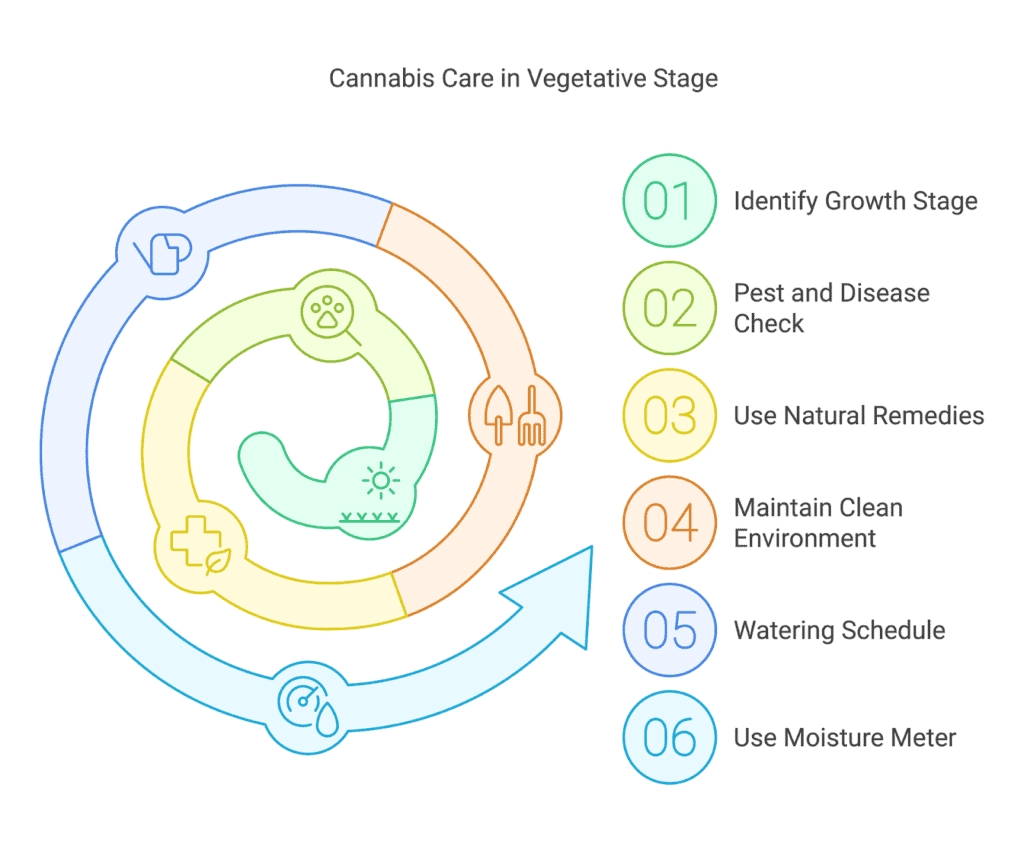
Healthy vegetative growth requires proper cannabis plant maintenance. This time promotes robust leaves and stems for plant growth. The watering and nourishment regimen and pest and disease management are crucial.
Pest and Disease Management
In the vegetative stage, disease and pest prevention are crucial. Check your plants regularly for issues. Common pests include aphids, spider mites, and whiteflies. Natural therapies include neem oil and insecticidal soap.
Maintain a clean growing environment. Remove rubbish and dead leaves that pests may hide in. Ladybugs can help manage natural populations.
Recognize illness immediately. Fungus infections can cause brown or yellow leaf patches. Reduce humidity via ventilation to prevent mold and mildew. Treat infected plants immediately to avoid spread.
Watering and Nutrient Schedule
Regular irrigation is essential for vegetative cannabis growth. If the top inch of soil seems dry, water your plants. Underwatering stresses plants, while overwatering causes root rot. Consider a moisture meter for accuracy.
Nitrogen-rich fertilizers are necessary for leaf and stem growth. Balanced nutrition helps. Follow fertilizer package dosage to avoid nutrient burn.
Providing nutrition every two weeks is beneficial during this period. Burnt tips or yellowing leaves suggest nutritional excess or lack. Adjust your feeding schedule to keep your plants healthy.
Getting Ready for Harvest

You must prepare your cannabis plants for harvest as they are near the end of the vegetative cycle. This involves choosing the best harvest period and using effective post-vegetative care.
Timing and Techniques
Harvesting at the correct time ensures high-quality buds. In general, trichome color indicates plant readiness.
- Trichomes that appear clear are too early.
- Cloudy trichomes indicate maximum potency
- Amber trichomes may indicate higher THC levels and less sedation.
Most growers aim for 70–80% hazy and 20–30% amber trichomes for a balance of potency and effects. Because strains vary, watch your plants’ flowering times.
Post-Vegetative Care
In order to create healthy buds, your plants will need special care after the vegetative stage. This involves lighting and nutrition adjustments.
- Switch to a potassium-phosphorus mix to promote flowering.
- Reduce the light cycle to 12 hours of light to promote flowering.
The appropriate temperature and humidity can also create the ideal habitat for bud development. Keep humidity around 40-50% to avoid mold, and ensure your temperature stays between 68-77°F during the light cycle.
Making these preparations can boost production and quality during harvest time.
Bottom Line
The vegetative stage is a critical phase in cannabis cultivation, laying the groundwork for robust growth and successful flowering. By providing optimal conditions, such as proper lighting, nutrients, and care, growers can ensure their plants develop strong roots, healthy foliage, and a resilient structure. Mastering this phase not only enhances plant health but also maximizes yields and sets the stage for a rewarding harvest.
Frequently Asked Questions on the Cannabis Vegetative Stage
For the best yield, how long does the vegetative stage last?
Depending on the strain and your development objectives, the vegetative stage usually lasts 4 to 8 weeks. In order to maintain a high yield later on, it’s critical to allow your plants adequate time to build a robust root system and foliage.
In the vegetative stage, what temperature range is best for cannabis?
The optimal daytime temperature range for the vegetative stage is 70°F to 85°F (21°C to 29°C). To prevent stress on the plants, nighttime temperatures should stay above 60°F (15°C).
What dietary needs does cannabis have while it is in the vegetative stage?
Nitrogen-rich fertilizer formulations are beneficial for vegetative cannabis plants. In order to sustain larger buds later on, this encourages healthy growth of the leaves and stems. For optimum health, you should also supply other vital micronutrients like potassium and phosphorus.
When should cannabis be moved from the vegetative to the flowering stages?
When your plants are sufficiently grown, which normally happens after 4 to 8 weeks of vegetative growth, you should move them to the flowering stage. The amount of room and light your plants have will also affect when to plant them.
How should cannabis plants be treated while they are in the vegetative stage?
Maintaining proper humidity, temperature, and light levels is part of proper care. Make sure your plants get 18 to 24 hours of light each day, keep an eye out for pests or illnesses, and modify your care regimen as necessary.
During the vegetative stage of cannabis, is it advantageous to prune fan leaves?
Fan leaf pruning promotes airflow and light penetration to the lower portions of the plant, which can be advantageous. However, as leaves are essential to photosynthesis and the general health of the plant, take care not to remove too many of them.








